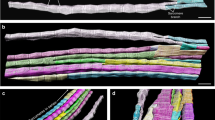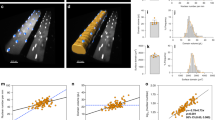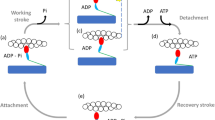Abstract
Adult mammalian twitch muscle fibres are extremely plastic, being able to transform from one type to another under the direction of their motoneurones1–3. The most unequivocal type of fibre transformation is that of fast-twitch to slow-twitch type, either with cross-reinnervation of the fast muscle with a slow nerve4–6, or with chronic low frequency stimulation of the intact nerve to a fast muscle7,8. Moreover, direct electrical stimulation of the muscle itself with a tonic pattern is just as effective in converting fast fibres to slow9. All these experiments suggest that activity of the muscle itself, imposed by whatever means, is crucial in the transformation of fast to slow fibres8–10. A similar transformation during development may be responsible for producing the adult diversity of fibre types, as fibres begin by synthesizing myosin of an embryonic type which is replaced by a neonatal type and finally the adult type of fast11 and slow12, which occurs concurrently with innervation. We report here that during development of the paired claw closer muscle in lobsters, reducing or eliminating activity in one of the muscles by tenotomy or denervation prevents its fast fibres from becoming transformed into slow. Our results therefore suggest a regulatory role for activity in the differentiation of lobster slow fibres.
This is a preview of subscription content, access via your institution
Access options
Subscribe to this journal
Receive 51 print issues and online access
$199.00 per year
only $3.90 per issue
Buy this article
- Purchase on Springer Link
- Instant access to full article PDF
Prices may be subject to local taxes which are calculated during checkout
Similar content being viewed by others
References
Guth, L. Physiol. Rev. 48, 645–687 (1968).
Harris, A. J. A. Rev. Physiol. 36, 251–305 (1974).
Gutmann, E. A. Rev. Physiol. 38, 177–216 (1976).
Buller, A. J. & Pope, R. Phil. Trans. R. Soc. 278, 295–305 (1977).
Close, R. J. Physiol., Lond. 204, 331–346 (1969).
Sreter, F. A., Luff, A. R. & Gergely, J. J. gen. Physiol. 66, 811–821 (1975).
Salmons, S. & Sreter, F. A. Nature 263, 30–34 (1976).
Salmons, S. & Henrikson, J. Muscle Nerve 4, 94–105 (1981).
Pette, D., Smith, M. F., Staudte, H. W. & Vrbova, G. Pflügers Arch. ges. Physiol. 338, 257–272 (1973).
Jolesz, F. & Sreter, F. A. A. Rev. Physiol. 43, 531–552 (1981).
Whalen, R. G. et al. Nature 292, 805–809 (1981).
Gauthier, G. F., Lowey, S. & Hobbs, A. Nature 274, 25–29 (1978).
Herrick, F. H. Bull. U.S. Fish. Commn. 15, 1–252 (1895).
Govind, C. K. & Lang, F. J. exp. Zool. 190, 281–288 (1974).
Jahromi, S. S. & Atwood, H. L. J. exp. Zool. 176, 475–486 (1971).
Lang, F., Costello, W. J. & Govind, C. K. Biol. Bull. 152, 75–83 (1977).
Lang, F., Govind, C. K. & She, J. Biol. Bull. 152, 382–391 (1977).
Govind, C. K. & Lang, F. Biol. Bull. 154, 55–67 (1978).
Ogonowski, M. M., Lang, F. & Govind, C. K. J. exp. Zool. 213, 359–367 (1980).
Emmel, V. E. J. exp. Zool. 5, 471–484 (1908).
Lang, F., Govind, C. K. & Costello, W. J. Science 201, 1037–1039 (1978).
Lang, F. Aquaculture 6, 389–393 (1975).
Padykula, H. A. & Hermann, E. J. Histochem. Cytochem. 4, 161–169 (1955).
Ogonowski, M. M. & Lang, F. J. exp. Zool. 207, 143–151 (1979).
Hajek, I., Chari, N., Bass, A. & Gutmann, E. Physiol. Bohemslov. 22, 603–612 (1973).
Lehman, W. & Szent-Gyorgi, A. G. J. gen. Physiol. 66, 1–30 (1975).
Govind, C. K. & Lang, F. J. exp. Biol. 94, 329–339 (1981).
Author information
Authors and Affiliations
Rights and permissions
About this article
Cite this article
Govind, C., Kent, K. Transformation of fast fibres to slow prevented by lack of activity in developing lobster muscle. Nature 298, 755–757 (1982). https://doi.org/10.1038/298755a0
Received:
Accepted:
Issue Date:
DOI: https://doi.org/10.1038/298755a0
This article is cited by
-
Fiber-type distribution in insect leg muscles parallels similarities and differences in the functional role of insect walking legs
Journal of Comparative Physiology A (2017)
-
The distribution of the common inhibitory neuron in brachyuran limb musculature
Journal of Comparative Physiology A (1988)
Comments
By submitting a comment you agree to abide by our Terms and Community Guidelines. If you find something abusive or that does not comply with our terms or guidelines please flag it as inappropriate.



